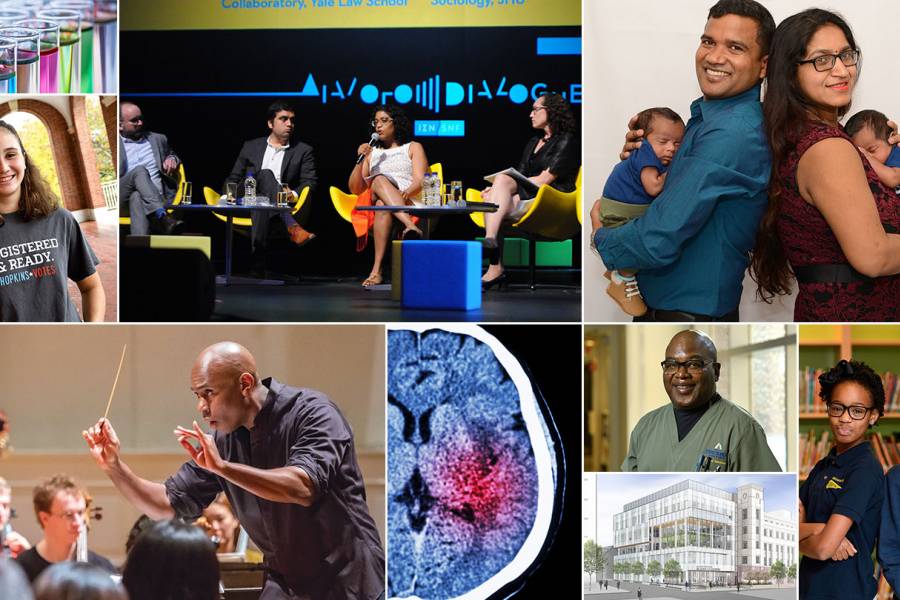In June 2013, Johns Hopkins University President Ronald J. Daniels announced the Ten by Twenty plan, his bold, wide-ranging vision for how the university community should rally to meet higher education's looming challenges and opportunities.
At the time, several issues were on the horizon, such as the uncertainty of federal funding for research and development, a changing global academic marketplace, and the evolution of student expectations for campus life.
With less than two years to go before the end of this ambitious initiative, how are we doing? Is the university meeting its goals? The Hub caught up with Daniels upon the release of the latest biennial Ten by Twenty progress report to take stock of the university's collective efforts.
Looking back over the past two years, what are some of the highlights for you? What are you most proud of?
A historic highlight is the transformative $1.8 billion gift from Michael Bloomberg, which will allow us to finally realize a long-held goal of officially becoming a need-blind and no-loan institution, ensuring that the most meritorious students will be able to participate fully in a Johns Hopkins education, irrespective of their families' financial circumstances.

Image caption: Johns Hopkins University President Ronald J. Daniels
I'm also deeply proud of the great strides we have made to bring Hopkins closer to the ideal of "one university," through new interdisciplinary institutes and faculty hires. In the past two years alone, we have launched the Stavros Niarchos Foundation Agora Institute and the Kissinger Center for Global Affairs and have welcomed a dozen more Bloomberg Distinguished Professors to multiple divisions. We have also extended funding for the Catalyst and Discovery awards, which support cross-divisional research collaboration.
In the last two years we have been able to extend supports like robust paid parental leave and better health insurance benefits for our faculty, staff, and students that enable them to flourish in all dimensions of their lives. And we have deepened our support for the city we call home through efforts like Vision for Baltimore and HopkinsLocal, which has outperformed our own goals for building, hiring, and buying locally.
What are some areas where we could be doing better?
We have made a lot of progress in supports for our undergraduate and graduate students—from more generous benefits to stronger career resources—but there is still more to do. I am excited about efforts underway in the Provost's Office to improve faculty mentoring guidelines for doctoral and postdoctoral trainees, and to rethink how we help our students design their futures.
We have more to do, as well, to advance diversity. Michael Bloomberg's gift is a major step in that direction in terms of our ability to recruit diverse students from every socioeconomic background and then give them comprehensive support when they arrive on campus. We're now in the fourth year of our five-year, $25 million Faculty Diversity Initiative and are seeing it bear fruit. And we're investing in programs aimed at helping our staff and boosting the culture and climate of university campuses, as well as engaging with Baltimore.
What's in store as we complete the final two years of Ten by Twenty? What are some of the initiatives currently under way that you are excited about?
The spring 2019 progress report highlights our accomplishments from January 2017 to December 2018. But so many exciting developments have taken place since the start of the new year. Last month, we announced that we are finally building a dedicated student center that will be social by design—with apologies to D-Level in the MSE Library. It will be a place to form friendships, launch projects, or simply unwind. In late January, we announced the acquisition of the iconic Newseum building, which will be the new home for Hopkins in D.C., mere steps from Capitol Hill.
Video credit: Len Turner
Of course, there is plenty to be excited about within the scope of this year's progress report. Renowned political scientist Hahrie Han will join us in July as the inaugural director of the Stavros Niarchos Foundation Agora Institute at Johns Hopkins University, and acclaimed architect Renzo Piano is designing the institute's new space at the Homewood campus, so I'm eager to see how the institute takes shape—physically and academically—in the years ahead.
We are also redoubling our commitment to the humanities, having invested more than $300 million, including a historic $75 million gift to our Philosophy Department by Wall Street legend and former Hopkins grad student Bill Miller.
In many ways the Ten by Twenty was an experiment in strategic visioning for the university. What lessons from the Ten by Twenty will you take into years 2021 and beyond?
At the core of the Ten by Twenty were four priorities: one university, individual excellence, commitment to our communities, and institution building. As we near the end of the Ten by Twenty, it is clear that these priorities will remain essential if we are to continue to excel. And it is equally clear that we need to advance these priorities in ways that are measurable and accountable.
Through historic gifts and work by many hands since 2013, Johns Hopkins now stands among the great American universities. As we move beyond 2020, our focus should continue to be on what makes us great—our outstanding faculty and students, our nearly 150-year tradition of pathbreaking research, and our commitment to sharing our knowledge with the wider world, starting here in Baltimore.
The 2019 progress report is available online at 10x2020progress.jhu.edu/2019/; the site includes a feedback form where you can share your thoughts and ideas about the Ten by Twenty. The next Idea Lab cycle is another way faculty, staff, and students can help shape the trajectory of the university based on the priorities outlined by the Ten by Twenty plan. Watch your inbox and the Hub for details on how you can participate in the fall 2019 cycle.
Posted in University News
Tagged president ron daniels, ten by twenty









